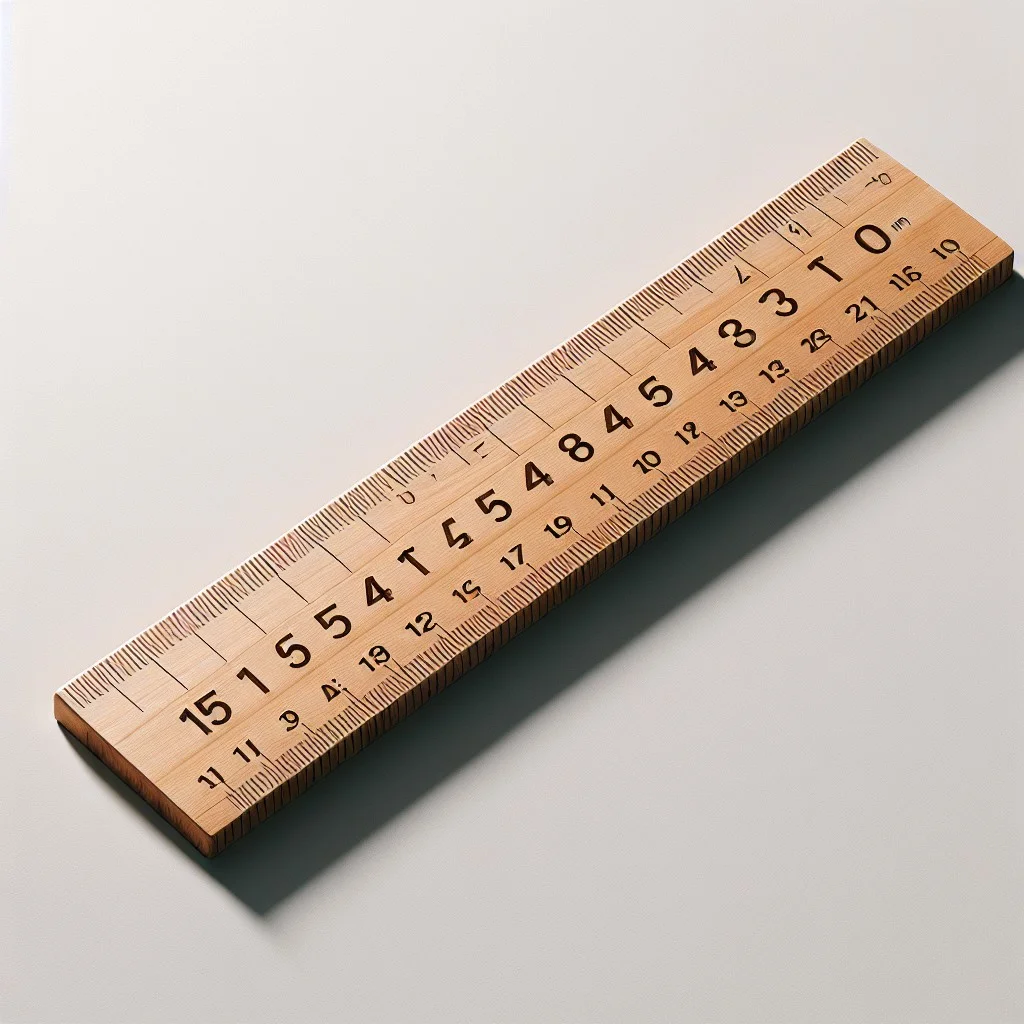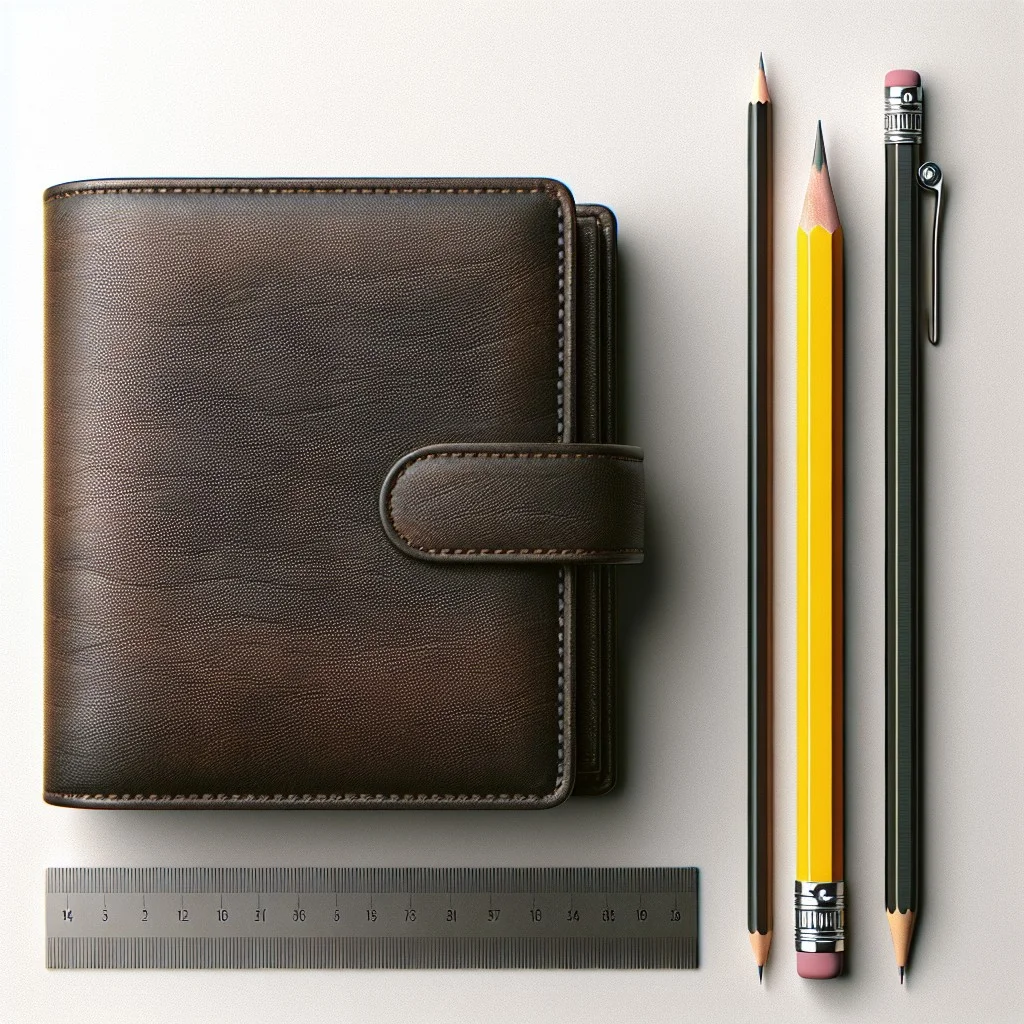Last updated on
Understanding the actual size of 15 cm becomes easier because this article unveils a host of familiar everyday items to draw compelling comparisons.
Key takeaways:
- 15 cm is precisely half the length of a standard ruler.
- 15 cm is enough fabric for a pocket or a patch.
- 15 cm is about the size of many modern smartphone screens.
- 15 cm is the length of a standard Bic pen or shorter than a typical ruler.
- 15 cm is approximately 5.91 inches when converted.
What's Inside
Understanding 15 Centimeters

Grasping the real-world dimensions of 15 cm requires tangible comparisons and a hands-on approach.
Imagine a standard ruler, which usually measures 30 cm; 15 cm is precisely half its length.
When purchasing fabric, if a retailer mentions 15 cm, envision a small swatch, enough for a pocket or a patch.
In the context of smartphone screens, 15 cm approaches the size of many modern displays, signifying an ample area for viewing content.
Using these concrete examples, the abstract measurement becomes a recognizable quantity, bridging the gap between numbers and everyday experiences.
Everyday Objects Measuring 15 Centimeters

Several common items can help you visualize the size of 15 centimeters. A standard pencil, not completely sharpened, is roughly this length, providing a handy reference. Look inside a toolbox, and a small hammer or a wrench might match up well.
In the office, a stack of sticky notes is typically 7.6 centimeters squared, meaning two stacks side by side measure close to 15 centimeters across. When it’s time to accessorize, a choker necklace often measures about 15 centimeters in diameter, lying comfortably around the base of the neck. If you enjoy reading, the short side of a standard paperback book usually comes close.
Embracing visuals will enhance grasp of the concept, making 15 centimeters tangible and relatable in everyday life.
Comparison With Standard Stationery
Visualizing 15 centimeters isn’t always straightforward, but comparing it to standard stationery items can instantly give you a clearer image:
- A standard ruler is typically 30 cm long, so 15 cm would be exactly half its length.
- Most pens measure around 14 to 15 cm, which makes a pen a handy reference point.
- A large highlighter is often just about 15 cm long.
- The short side of a B6 size notebook is approximately 15 cm.
Remember, these comparisons can vary slightly depending on the design and brand, but they offer a good ballpark figure to gauge the size of 15 cm.
Sizes in the Kitchen: The Length of Common Food Items
Visualize a standard butter knife from your cutlery set; it’s roughly the same span. Now, imagine a row of sugar cubes lined up end-to-end – about six would equate to this measurement.
If you delve into baking, a half-rolled-out pie crust typically extends beyond this length, offering a tangible reference from the baking world.
When selecting produce, a medium-sized banana or a large bell pepper can give you a real-life sense of the dimension we’re discussing.
Even portions of fresh fish or cuts of meat, commonly found on a dinner plate, fall into this approximate size range.
Grasping the concept through these familiar kitchen items makes measurement more intuitive and less reliant on a ruler or measuring tape for day-to-day estimations.
Technology Comparison: Gadget Sizes
Smartphones and small gadgets often provide a practical reference for visualizing 15 centimeters. For instance, many phone screens are around that length diagonally, which means from one corner to the opposite one. A compact digital camera or a portable power bank could also echo these dimensions.
When considering the thickness of multiple smartphones stacked together or the width of a tablet in landscape mode, it’s easy to see how 15 cm plays a part in tech design. This size is not just arbitrary—it’s chosen for portability and ease of use, keeping devices within a comfortable range for handling and pocket storage.
Comparison With Currency: Coins and Bills
Visualizing 15 centimeters in terms of currency helps anchor the measurement in reality. For starters, a standard US dollar bill is just over 15 cm in length, offering a practical reference point. Laying two bills end-to-end exceeds 15 cm slightly, providing a tangible representation.
In other currencies, such as the Euro, a 50 Euro note is shorter, around 14 centimeters, making it just shy of the 15 cm mark. Across the pond, the British £10 note also comes close, measuring approximately 13.5 cm in length.
When it comes to coins, imagine stacking them to reach the vertical height of 15 cm. Take the Euro once more: with a 2 Euro coin having a thickness of about 2.2 mm, you would need to stack around 68 coins to match the height of 15 cm.
This currency comparison offers a hands-on approach to gauge the size of 15 centimeters without the need for a ruler or measuring tape, connecting everyday monetary objects to measurements.
Proportions in Nature: Seeds and Nuts
Delving into the natural world, we uncover a multitude of seeds and nuts that can give us a tangible sense of how long 15 cm is. Consider the average length of a sunflower seed, which is about 1.5 cm; line up ten of these seeds, and you’ve reached the 15 cm mark. On the larger end, a walnut measures roughly 3–4 cm across; four of these side by side could help you visualize this dimension. Using these natural benchmarks, you’ll find you have a handy tool for approximating this measurement when you’re out in the wild or in the comfort of your own home.
Comparison With Body Parts
When estimating the length of 15 centimeters using the human body, consider the following:
- Average Adult Hand: From the wrist to the tip of the middle finger, the span is often greater than 15 cm, but the distance from the tip of the thumb to the tip of the pinkie finger, when the hand is spread, can approximate this measure.
- A Child’s Footprint: Depending on the child’s age and growth, 15 cm closely matches the length of a toddler’s foot.
- Palm Size: For many adults, the breadth of the palm is close to this length, providing a handy reference point.
- Index Finger: In some individuals, the length from the tip of the index finger to the proximal knuckle might be near to 15 cm.
Using common body parts as a guide simplifies visualizing and comparing the length of 15 centimeters in everyday situations.
How To Convert 15 Cm To Inches Effortlessly?
Converting centimeters to inches is a simple process that requires only one basic formula: the number of centimeters multiplied by the conversion factor of 0.393701. To put this into action for 15 cm, multiply 15 by 0.393701, which results in approximately 5.90551 inches.
Here’s a step-by-step breakdown:
- Start with the number of centimeters: In this case, 15 cm.
- Multiply by the conversion factor: The constant (0.393701) is the number of inches in one centimeter.
- Perform the calculation: 15 * 0.393701 = 5.90551.
This calculation shows that 15 cm equals about 5.91 inches when rounded to two decimal places. Utilizing this method, one can quickly calculate any value in centimeters to inches without the need for complex conversions or tools.
Centimeters to Inches Conversion Chart
A handy conversion chart greatly simplifies the process of turning centimeters into inches, giving you a quick reference to make measurement-related tasks a breeze. If you need to find out how 15 cm measures up in inches, just look at the chart where 1 centimeter equals approximately 0.3937 inches. Therefore, 15 centimeters would be close to 15 x 0.3937, which is about 5.9055 inches.
Keep in mind, measurement precision matters in some scenarios, like engineering or scientific research, but a rounded-off number is typically sufficient for everyday use. Thus, you can simply remember that 15 cm is roughly equal to 6 inches if a ballpark figure is all you require.
Remember, when in doubt or if you need an exact number, use the precise multiplier (0.3937) or a calculator for conversion to ensure accuracy.
Defining a Centimeter
A centimeter is a metric unit of length that is 1/100th of a meter. To help visualize a centimeter:
- Think about the width of a standard-sized paperclip, which is close to a centimeter wide.
- It’s roughly equivalent to the diameter of a button on your shirt.
- The thickness of a standard pencil is about the same.
The metric system, where the centimeter originates, is based on powers of ten, making calculations with this unit straightforward and universal in science and most countries around the world.
Defining an Inch
An inch has long stood as a fundamental unit of length in the British imperial and the United States customary systems. Traditionally, it’s equivalent to 1/12 of a foot or 1/36 of a yard.
Let’s distill this concept:
- Origin: The term inch comes from the Latin word “uncia,” which was a unit that represented one-twelfth of a Roman foot.
- Modern standards: An inch is officially standardized to be exactly 2.54 centimeters, ensuring consistency in measurements.
- Usage: Inches are commonly used in the United States, Canada, and the United Kingdom for everyday measurements, including screen sizes, product dimensions, and more.
- Symbol: An inch is typically denoted by the double prime symbol (“).
Understanding this unit is crucial when you’re looking to grasp the metric-imperial conversion, or simply if you want to communicate measurements with precision in contexts where the imperial system is dominant.
The Relationship Between Centimeters and Inches
Centimeters and inches are both units used to measure length, but they stem from different measurement systems. Centimeters are part of the metric system, which is based on multiples of ten, making it quite straightforward to understand and use. The inch, on the other hand, is a part of the imperial system, predominantly used in the United States.
To navigate the relationship between these two units, it’s helpful to know the exact conversion value. One inch is equivalent to 2.54 centimeters. This means that whenever you need to convert inches to centimeters, you multiply the inch value by 2.54. Conversely, to convert centimeters to inches, you divide the centimeter value by 2.54.
This relationship is crucial because it allows for accurate conversions between the metric and imperial systems, facilitating international trade, scientific communication, and personal understanding of different product sizes. Armed with this knowledge, you can seamlessly transition between the two systems with confidence.
Comparing Centimeters And Inches
Centimeters and inches are common units of length, rooted in different measurement systems—the metric system and the imperial/US customary systems, respectively. Here’s a closer look at how these two units compare:
1. Scale Difference: An inch is longer than a centimeter. Precisely, one inch equals approximately 2.54 centimeters.
2. Usage by Region: Inches are predominantly used in the United States, whereas most other countries rely on centimeters as part of the metric system.
3. Visualizing Lengths: To picture an inch, think of the width of a thumb. For centimeters, envisage the width of a large paperclip.
4. Converting with Multiplication: To translate centimeters to inches, divide by 2.54. Conversely, multiply inches by 2.54 to get centimeters.
Understanding this conversion allows for easy transitions between the two units, ensuring accurate measurements regardless of the preferred system.
FAQ
What size is 15 cm in inches?
The size of 15 cm is approximately equivalent to 5.91 inches.
Is 6 inches 15 cm?
Yes, 6 inches are approximately equal to 15.24 centimeters.
How long is 15 cm compared to an object?
Fifteen centimeters is nearly equivalent to half a foot in length.
How big is a cm example?
One centimeter (cm) is approximately the diameter of a typical Cheerio.
Can 15 cm be equated to a common item for better understanding?
Yes, 15 cm is approximately the length of a standard Bic pen.
How does 15 cm measure up against standard stationery items?
A 15cm measurement is approximately the length of a standard Bic pen or a bit shorter than a typical ruler, which is usually 30 cm long.
What fraction of a meter does 15 cm represent?
15 centimeters represent 0.15 of a meter.




